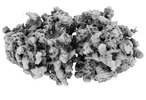+Search query
-Structure paper
| Title | A distinct mammalian disome collision interface harbors K63-linked polyubiquitination of uS10 to trigger hRQT-mediated subunit dissociation. |
|---|---|
| Journal, issue, pages | Nat Commun, Vol. 13, Issue 1, Page 6411, Year 2022 |
| Publish date | Oct 27, 2022 |
 Authors Authors | Momoko Narita / Timo Denk / Yoshitaka Matsuo / Takato Sugiyama / Chisato Kikuguchi / Sota Ito / Nichika Sato / Toru Suzuki / Satoshi Hashimoto / Iva Machová / Petr Tesina / Roland Beckmann / Toshifumi Inada /    |
| PubMed Abstract | Translational stalling events that result in ribosome collisions induce Ribosome-associated Quality Control (RQC) in order to degrade potentially toxic truncated nascent proteins. For RQC induction, ...Translational stalling events that result in ribosome collisions induce Ribosome-associated Quality Control (RQC) in order to degrade potentially toxic truncated nascent proteins. For RQC induction, the collided ribosomes are first marked by the Hel2/ZNF598 E3 ubiquitin ligase to recruit the RQT complex for subunit dissociation. In yeast, uS10 is polyubiquitinated by Hel2, whereas eS10 is preferentially monoubiquitinated by ZNF598 in human cells for an unknown reason. Here, we characterize the ubiquitination activity of ZNF598 and its importance for human RQT-mediated subunit dissociation using the endogenous XBP1u and poly(A) translation stallers. Cryo-EM analysis of a human collided disome reveals a distinct composite interface, with substantial differences to yeast collided disomes. Biochemical analysis of collided ribosomes shows that ZNF598 forms K63-linked polyubiquitin chains on uS10, which are decisive for mammalian RQC initiation. The human RQT (hRQT) complex composed only of ASCC3, ASCC2 and TRIP4 dissociates collided ribosomes dependent on the ATPase activity of ASCC3 and the ubiquitin-binding capacity of ASCC2. The hRQT-mediated subunit dissociation requires the K63-linked polyubiquitination of uS10, while monoubiquitination of eS10 or uS10 is not sufficient. Therefore, we conclude that ZNF598 functionally marks collided mammalian ribosomes by K63-linked polyubiquitination of uS10 for the trimeric hRQT complex-mediated subunit dissociation. |
 External links External links |  Nat Commun / Nat Commun /  PubMed:36302773 / PubMed:36302773 /  PubMed Central PubMed Central |
| Methods | EM (single particle) |
| Resolution | 3.0 Å |
| Structure data | EMDB-14181, PDB-7qvp: |
| Source |
|
 Keywords Keywords | TRANSLATION / disome / di-ribosome / XBP1 / ribosome / collision |
 Movie
Movie Controller
Controller Structure viewers
Structure viewers About Yorodumi Papers
About Yorodumi Papers





 homo sapiens (human)
homo sapiens (human)